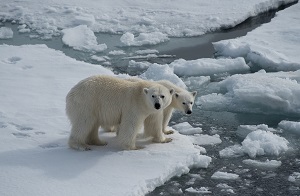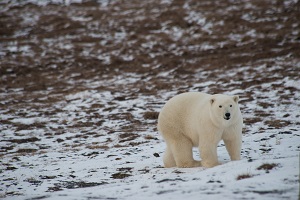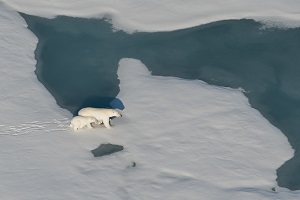Rosneft Continues Research of Polar Bear Population

The International Polar Bear Day is annually celebrated on the 27th of February in order to draw additional attention to the protection of the biggest terrestrial carnivore on our planet.
Rosneft considers the preservation and protection of polar bears as one of its priorities in the field of environmental protection. The polar bear is one of the main species--indicators of the sustainable condition of Arctic ecosystems, standing at the top of the food chain. The population of these animals is currently estimated at 22,000-31,000 specimen. The most part of their range is located in the Russian part of the Arctic.  At that, the special conservation status of the polar bear has force throughout the entire range--they are included in the Red Book of the Russian Federation and in the Red List of the International Union for Conservation of Nature and Natural Resources.
At that, the special conservation status of the polar bear has force throughout the entire range--they are included in the Red Book of the Russian Federation and in the Red List of the International Union for Conservation of Nature and Natural Resources.
Since 2013, all polar bears in all Russian zoos are in the custody of the Company to be provided with adequate nutrition, veterinary service and improved living conditions. Since 2014, the Rosneft Arctic Research Centre together with the Marine Mammals Council study polar bears using advanced technologies. Field studies include registering polar bears and their traces, biological sampling, zoological surveys including temporary immobilization of animals, measuring, sampling for the following laboratory processing and placement of satellite transmitters.
 Laboratory analysis of samples makes it possible to evaluate animals’ condition in a comprehensive manner. Samples obtained during expeditions are subject to molecular-genetic, microbiological, haematological and toxicology tests. Toxicology tests of blood, fur and subcutaneous fat reveal content and level of contamination, including this of anthropogenic origin. The data obtained provide basis for the following monitoring of Arctic marine ecosystems, the condition of which is indicated by polar bears.
Laboratory analysis of samples makes it possible to evaluate animals’ condition in a comprehensive manner. Samples obtained during expeditions are subject to molecular-genetic, microbiological, haematological and toxicology tests. Toxicology tests of blood, fur and subcutaneous fat reveal content and level of contamination, including this of anthropogenic origin. The data obtained provide basis for the following monitoring of Arctic marine ecosystems, the condition of which is indicated by polar bears.
 In 2020, during field studies in the Russian Arctic National Park on the Cape Zhelaniya of Severny Island of the Novaya Zemlya archipelago scientists carried out coastal observations of the Kara-Barents Sea polar bear population and evaluated its age and gender composition. The scientists carried out morphometric measurements and veterinary check-ups, evaluated the physical condition of the animals and took blood and fur samples for the following analysis. Mapping of polar bear dens was carried out on Vrangel and Gerald islands in Chukchi Sea.
In 2020, during field studies in the Russian Arctic National Park on the Cape Zhelaniya of Severny Island of the Novaya Zemlya archipelago scientists carried out coastal observations of the Kara-Barents Sea polar bear population and evaluated its age and gender composition. The scientists carried out morphometric measurements and veterinary check-ups, evaluated the physical condition of the animals and took blood and fur samples for the following analysis. Mapping of polar bear dens was carried out on Vrangel and Gerald islands in Chukchi Sea.
The results significantly expand and actualize information on the polar bear population living in the Russian Arctic - their migration routes, the physical condition of the specimen, and help to develop activities for animal preservation.
Note for Editors:
The following are some facts about the polar bear:
1. The largest bear. Being the largest predator onshore, the polar bear can weight about 700 kilogram and reach 3 metres lengthwise.
2. Thermal isolation. The polar bear’s fur is not actually white but transparent; the hair is hollow and filled with air that helps the animals to save heat better.
3. New-born cubs are about the size of a guinea pig. They come out the lair 4-5 months later. The cubs will stay with their mother for about two years, during which they will learn the skills required for survival in the Arctic.
4. Offspring of polar and brown bears Most recently, in 2006, genetic testing confirmed the existence of hybrids of polar bears and grizzlies (a subspecies of a brown bear living in western Canada and Alaska), also known as a grolar (grizzly + polar), or a polar grizzly (Ursus arctos × maritimus). The hybrid looks like an intermediate between the two species, but since wild hybrids are usually born from polar-bear mothers, they grow and behave like polar bears. Their ability to cross is not surprising, considering that polar bears evolved from brown bears only 150 years ago!
Rosneft
Information Division
February 26, 2021